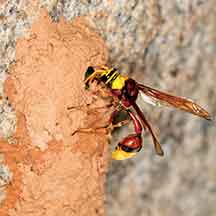Geetha Iyer
Humans fear them because they sting! Their slender abdomens are the dreams of waist conscious fashionable women! Farmers welcome them but take care to get out of their way. Stand still, they cannot see you, move and they will detect your presence! Wasps! Villains and heroes, feared or liked, by both the human society and the insect community. Despite the fearsome reputation, it must be said in their favour that not all wasps sting; those that do will not harm you unless you are interfering with their lives. You can safely stand still and watch them shape the clay – a technique that needs no potter’s wheel, no hands, no water to dabble, just their mouth parts to fashion out the pots and jugs like the expert potter.

Wasps may lead a solitary life or live in colonies. The solitary ones could be parasitic or free living. The homes that the free living ones build are for raising their young, never as a dwelling for themselves. Wasps that build nests using clay or lime are commonly referred to as potter wasps and mud dauber wasps. They are a cosmopolitan group, with differing habits, belonging to different families. The common feature is that they are all solitary and build using clay. It’s fascinating to see how they make their nests.
The author is a consultant for science and environment education. She can be reached at scopsowl@gmail.com.
